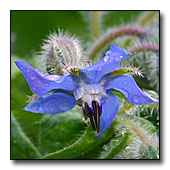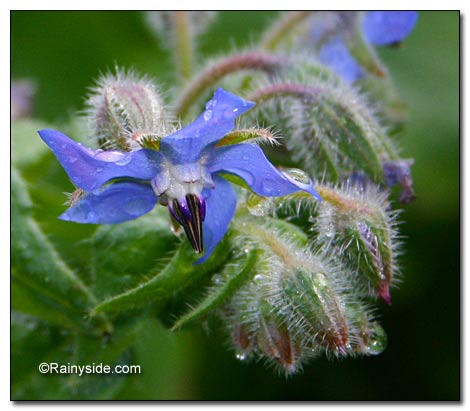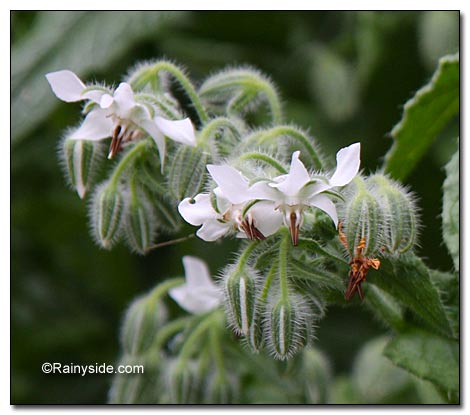Borago officinalis
BORAGE
Family: Boraginaceae
Pronounced: bo-RAH-go o-fi-seh-NAL-is

Quick Jumps
Growing Guide
Rainy Side Notes
GROWING GUIDE

Origin:
Europe.
Plant Group:
Herbs.
Hardiness:
Sunset zones: A2, A3; 1-24; H1.
USDA zones: All.
Heat zones: 12-1.
Mature size:
Height: 2 feet (60 cm).
Width: 18 inches (45 cm).
Flowering period:
Summer to killing frost.
Flowering attributes:
Cymes of bright blue, star-shaped, nodding flowers, with purple black anthers that form a cone. Flowers fade to pink as they age.
Leaf attributes:
Hairy, lance shaped.
Growth habit:
Coarse growth.
Light:
Full sun to partial shade.
Soil:
Well-drained soil.
Feeding:
None required.
Propagation Methods:
Sow seed in situ from early to mid spring. Cover seed with soil.
Rainy Side Notes

When introducing this seedling to someone, I warn them, "Once you have borage, you will always have borage!" It reseeds quite generously but is easy to keep under control by deadheading the flowers.
This herb's rich history connects us to the past and the diverse cultures that valued this herb.The Celtics, for instance, added it to their wine to bolster their spirits before battle. On the other hand, the Welsh saw it as the 'herb of gladness.' The Romans believed that borage flowers could lighten the spirits, and the English prescribed the herb to ease melancholy.
I use fresh leaves for cooking or teas since they lose flavor when dried. Harvest the leaves anytime, but harvest the flowers just as they open. The flowers can be dried face down on a screen for culinary use. You can also dry them in silica gel for best color retention, but do not use these flowers for culinary purposes. Borage flowers also press beautifully.
The nectar-rich flowers are a must for any pollinator garden.
I admire this stout annual herb with its sky-blue flowers that turn pink as the flower ages. The 'Alba' cultivar, with its white flowering form, is a lovely addition to a moonlight garden. Borago 'Variegata' has variegated leaves that a virus may cause.
Don't let Borage's reputation for reseeding intimidate you. With a few simple steps, you can easily manage it. Sow seeds in March in a sunny location, and you'll find the plant grows on almost any soil. To keep a few plants flowering throughout summer, sow seed again in April and May. As it ages, Borage tends to get coarse. But don't worry, it's easy to manage. One way to prevent excessive reseeding is deadheading the flower heads or pulling plants entirely before seeds form. This prevents the plant from producing seeds, reducing the number of seedlings for the next season. With these tips, you'll be in complete control of your borage plants.
If you want more seedlings, pull up the plants after seeds form and shake the plant to make the seeds fall out for next year's plants. Some seeds may sprout and bloom before the first frost in autumn.
You can easily cultivate this versatile and beautiful herb with just a little care and attention. It's a straightforward process that anyone can master.
Photographed in author's garden.

Gardening for the Homebrewer: Grow and Process Plants for Making Beer, Wine, Gruit, Cider, Perry, and More
By co-authors Debbie Teashon (Rainy Side Gardeners) and Wendy Tweton
Copyright Notice | Home | Search | Herbs

